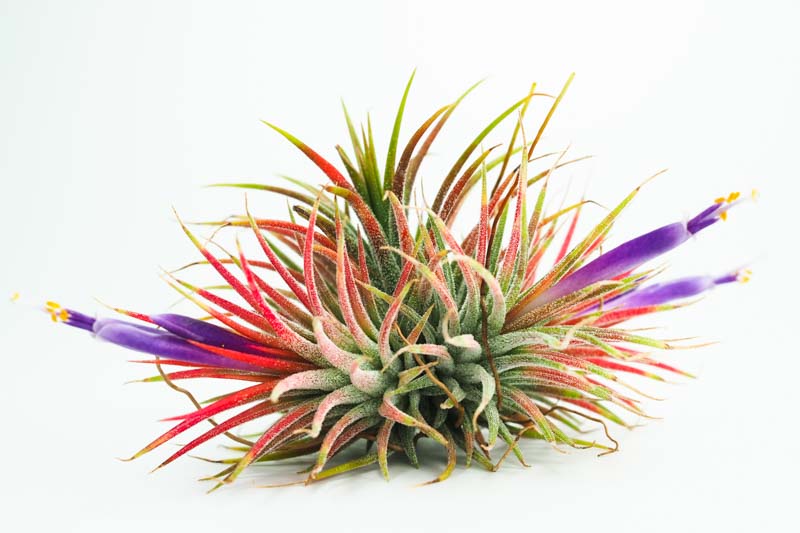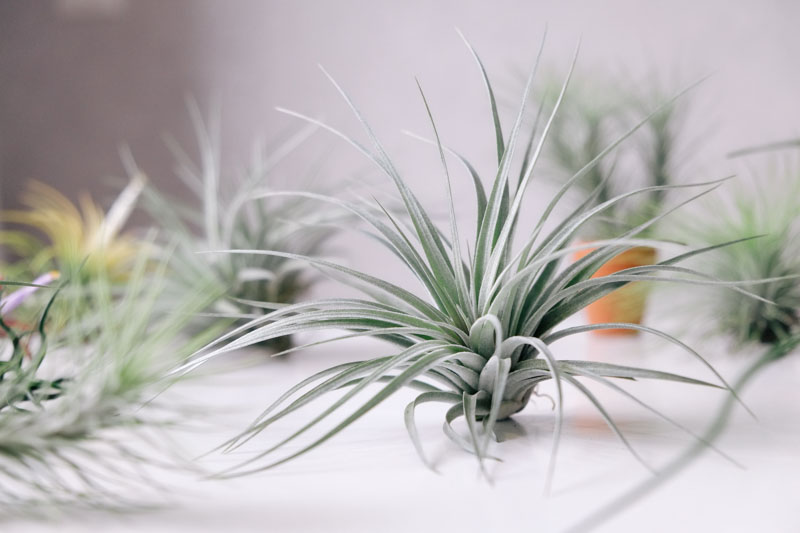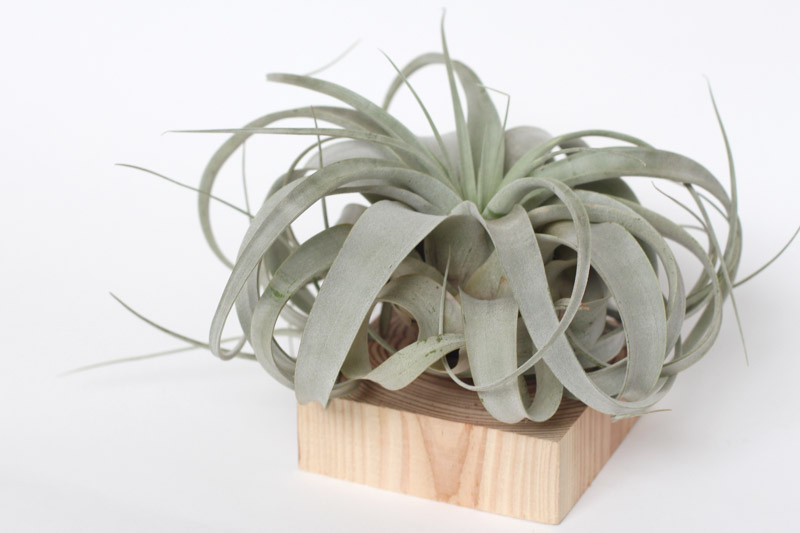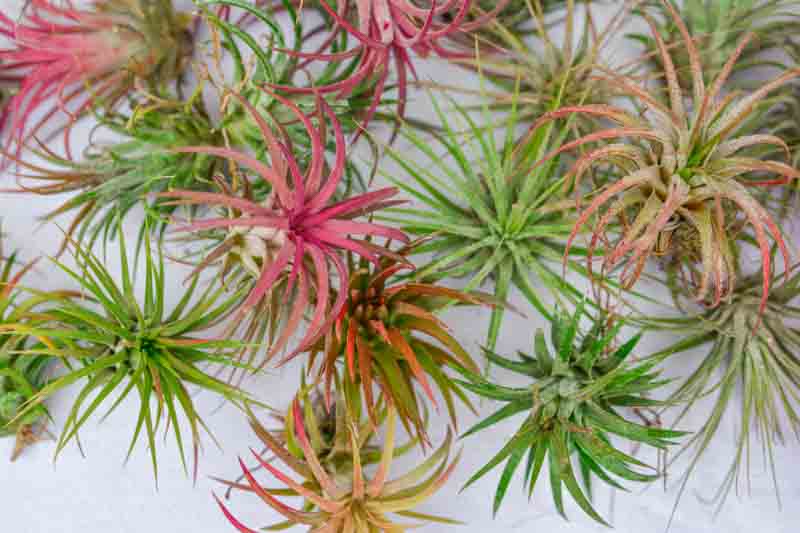Tillandsia ionantha , Tillandsia xerographica, Tillandsia cyanea, Tillandsia recurvata, Tillandsia caput-medusae, Tillandsia streptophylla, Tillandsia bulbosa, Air Plant
Tillandsia, commonly known as air plants, belong to the bromeliad family and have captivated enthusiasts with their soil-less nature and unique growth habits. Plants do not require soil to grow, making them incredibly versatile for display. These remarkable plants absorb water and nutrients through their leaves from the air, making them a fascinating addition to indoor and outdoor gardens. Air
With over 650 species, Tillandsia boasts a wide variety of shapes, sizes, and colors, ranging from silvery-green to vibrant flowering specimens.
Air plants grow on other plants, rocks, or structures without drawing nutrients from them, unlike parasitic plants. They have specialized leaves covered in tiny scales called trichomes, which absorb moisture from the air and provide the plant with water and nutrients.
Native: These plants are native to the forests, mountains, and deserts of Central and South America, Mexico, and parts of the southern United States. The genus encompasses a diverse range of species, including the popular Tillandsia ionantha, Tillandsia xerographica, and Tillandsia usneoides (Spanish moss). Air plants belong to the bromeliad family (Bromeliaceae), along with the pineapple or the urn plant.
Plant Type and Habit: Air plants are perennial flowering plants that exhibit various growth habits, from compact rosettes to elongated, vine-like forms. Their adaptability allows them to thrive in a wide range of environments, from rainforests to arid deserts.
Size: The size varies significantly across species, from tiny, few-inch specimens to large, sprawling plants that can reach several feet in diameter.
Flowers: One of the most appealing aspects of Aair plants is their vibrant flowers, which can range in color from bright red and pink to purple and blue. The blooms are often striking and contrast beautifully against the plant’s foliage. Flowering times vary by species, with many blooming in late winter through spring. Flowers can last from several days to a few months, depending on the species and environmental conditions. After flowering, some Tillandsias produce seed pods that open to release seeds equipped with silken parachutes for wind dispersal.
Foliage: The foliage varies among species, from thin, needle-like leaves to broad, flat leaves, often with a silvery or fuzzy appearance due to trichomes. It may also change color when the plant is in bloom.
Hardiness: Air plants are hardy in USDA zones 9-13 if grown outdoors; however, they are primarily kept as indoor plants where they can be protected from extreme temperatures. For most species, the ideal growth temperature is between 68-77°F (20-25°C), with a minimum of 50°F (10°C) and a maximum of 86°F (30°C).
Uses: Tillandsias are versatile in their use, popular in terrariums, mounted on driftwood or bark, or simply displayed in glass globes or on shelves. They’re used in home decor, weddings, and as unique gifts.
Toxicity: Air plants are non-toxic to humans and pets, making them safe to include in household and office settings.
Benefits: Air plants are not only decorative but also improve air quality by absorbing carbon dioxide and releasing oxygen. They can increase humidity in a room, which may be beneficial during dry months.

Tillandsia ionantha
Caring for air plants is relatively straightforward, making them perfect for those new to plant care or looking to expand their indoor garden with minimal effort plants.
Light: Air plants prefer bright, indirect sunlight. A spot near a window that gets plenty of light but not direct sun is ideal. In dimmer areas, a fluorescent or LED grow light can provide supplemental light.
Misting: Mist your plants 2-3 times a week with a spray bottle, more often in hot, dry conditions. Ensure the entire plant gets wet.
Soaking: Every 1-2 weeks, submerge your air plants in room temperature water for about 20-30 minutes. After soaking, shake off excess water and place them upside down on a towel to dry completely to prevent water from collecting in the base, which can cause rot. Adjust watering frequency based on humidity, temperature, and air circulation in your environment. Air plants in drier or hotter conditions may require more frequent watering.
Air Circulation: Good air circulation is crucial for air plant health. After watering, allow plants to dry thoroughly in a space with ample airflow. Stagnant, moist conditions can lead to rot and fungal issues.
Temperature and Humidity: These plants are tropical and prefer temperatures between 50-86°F (10-30°C). For most species, the ideal growth temperature is between 68-77°F (20-25°C). Protect them from frost and extreme heat, which can damage or kill the plant.
Fertilization: Use a bromeliad or orchid fertilizer (diluted to ¼ strength) once a month during spring and summer to encourage growth and blooming. Alternatively, you can use a balanced liquid fertilizer at a reduced strength.
Mounting and Display: Air plants can be displayed in various ways, including mounted on wood, placed in terrariums, or simply set on shelves. Avoid copper wire or containers, as copper is toxic to Tillandsias.
Pruning: Trim any brown or dead leaves with sterile scissors to keep the plant healthy and aesthetically pleasing. This also helps prevent rot.
Blooming: Most air plants will bloom once in their lifetime, producing vibrant and exotic flowers. After blooming, the plant will produce offsets, or “pups,” which you can separate and grow as new plants once they are large enough.

Tillandsia caput-medusae
Propagating air plants is a simple and rewarding process, allowing you to expand your collection from the offspring of a single plant. The tropical plants reproduce by producing offsets, commonly called “pups,” which grow from the mother plant’s base.

Tillandsia xerographica
Air plants are generally robust and have few problems, but like all plants, they can encounter pests and diseases if not cared for properly. Here are some common issues that may affect air plants and how to address them:
Spider Mites: These pests, indicated by fine webbing and yellowing leaves, thrive in dry conditions. Increase humidity and wash the plant under a gentle stream of water to dislodge the mites.
Mealybugs: These tiny, white, cotton-like pests can hide in the crevices of air plants, sucking sap and weakening the plant. Treat by dabbing the pests with a cotton swab dipped in rubbing alcohol or using insecticidal soap.
Scale insects: Hard or soft scale insects might also infest air plants, appearing as small bumps on leaves or stems. Remove them manually with a toothpick or treat them with insecticidal soap.
Rot: Although air plants don’t have traditional roots, the base of the plant can rot if it remains too wet. Ensure your plant dries thoroughly within 4 hours after watering. If rot sets in, remove the damaged parts and adjust your watering routine.
Leaf spot: Fungal or bacterial leaf spots can occur, especially if water sits on the leaves for too long in low-light conditions. Improve air circulation and ensure the plant can dry properly after watering.
Dehydration: Signs include wrinkled or rolled leaves. Air plants need more water than one might expect. If your plant looks dehydrated, soak it in water for a few hours.
Sunburn: Brown, crispy spots on the leaves may indicate too much direct sunlight. Move your plant to a location with bright, indirect light.
Fading or Bleaching Leaves: A sign of too much light. Gradually move your plant to a slightly shadier spot.
Frost Damage: If exposed to cold temperatures, air plants can suffer frost damage, showing as black or dark brown, mushy leaves. Protect air plants from temperatures below 45°F (7°C).

Yes, air plants are excellent for indoor environments. They don’t require soil, making them versatile for display. Their ability to purify the air and increase humidity slightly, alongside their minimal care requirements, makes them ideal for adding greenery indoors.
Air plants can live for several years, with some species living up to 20 years or more. They have a one-time blooming cycle but produce offsets, or “pups,” which can be separated and grown into new plants.
Yes, after blooming, air plants produce offsets (pups) at their base. A single plant can produce several pups, which can be left to form a clump or separated to grow individually once they are about one-third the size of the mother plant. This multiplication process allows your air plant collection to grow and replenish over time.
| Hardiness |
9 - 13 |
|---|---|
| Plant Type | Houseplants, Perennials |
| Plant Family | Bromeliaceae |
| Exposure | Partial Sun |
| Season of Interest |
Spring (Early, Mid, Late) Summer (Early, Mid, Late) Fall Winter |
| Height |
2" - 7' (5cm - 210cm) |
| Maintenance | Low |
| Characteristics | Showy, Evergreen |
| Hardiness |
9 - 13 |
|---|---|
| Plant Type | Houseplants, Perennials |
| Plant Family | Bromeliaceae |
| Exposure | Partial Sun |
| Season of Interest |
Spring (Early, Mid, Late) Summer (Early, Mid, Late) Fall Winter |
| Height |
2" - 7' (5cm - 210cm) |
| Maintenance | Low |
| Characteristics | Showy, Evergreen |
How many Tillandsia (Air Plants) do I need for my garden?
| Plant | Quantity | |
|---|---|---|
| Tillandsia (Air Plants) | N/A | Buy Plants |
Create a membership account to save your garden designs and to view them on any device.
Becoming a contributing member of Gardenia is easy and can be done in just a few minutes. If you provide us with your name, email address and the payment of a modest $25 annual membership fee, you will become a full member, enabling you to design and save up to 25 of your garden design ideas.
Join now and start creating your dream garden!
Create a membership account to save your garden designs and to view them on any device.
Becoming a contributing member of Gardenia is easy and can be done in just a few minutes. If you provide us with your name, email address and the payment of a modest $25 annual membership fee, you will become a full member, enabling you to design and save up to 25 of your garden design ideas.
Join now and start creating your dream garden!